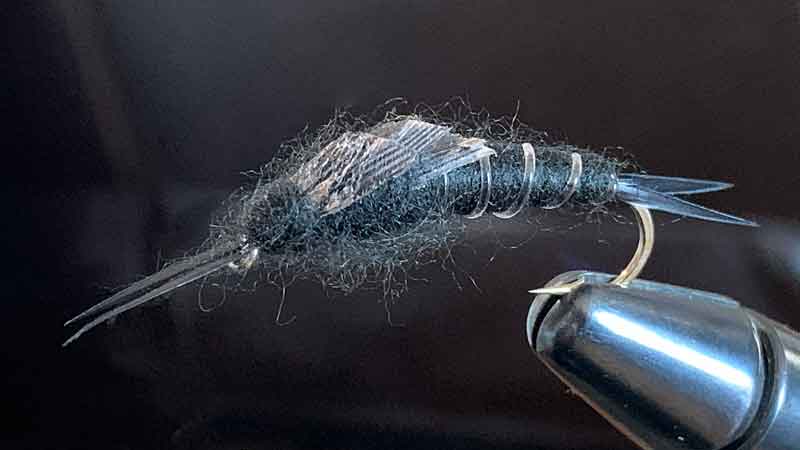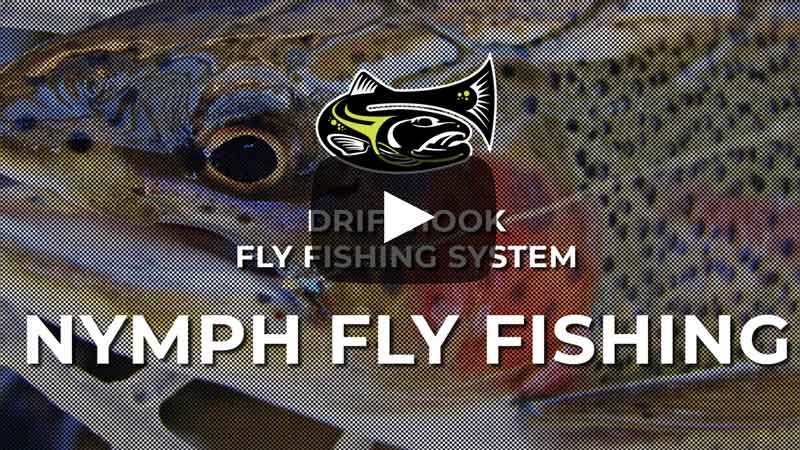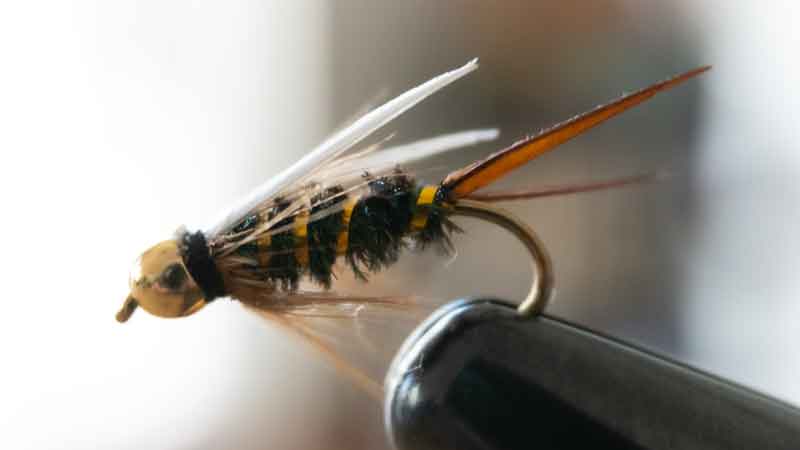Fly fishing is an art that brings anglers closer to nature. It requires an understanding of aquatic life and the delicate balance within ecosystems. The black stonefly nymph is one of the essential fly patterns in any angler’s arsenal.
The black stonefly nymph is a fly pattern designed to imitate the nymph stage of the stonefly, an aquatic insect found in clean, fast-flowing streams and rivers. Stoneflies are an important food source for many freshwater fish species, making the black stonefly nymph an effective and versatile fly for fly fishing.
This guide will provide a comprehensive look at the black stonefly nymph, covering its history, the materials needed to tie it, tying instructions, variations, and effective fishing techniques.

Characteristics of the Black Stonefly Nymph
Stonefly nymphs are characterized by their elongated bodies, segmented abdomens, and prominent wing pads. They have two antennae and two tails, with six legs positioned towards the front of their bodies. The black stonefly nymph pattern imitates these features, using materials that mimic the natural insect's appearance and movement in the water. The dark coloration of this pattern is particularly effective in low-light conditions and when stoneflies are present in the water.
Importance in Fly Fishing

Stonefly nymphs are a vital part of the aquatic food chain and are eagerly consumed by trout and other fish species. The black stonefly nymph pattern is highly effective because it closely resembles a natural prey item, triggering feeding responses from fish. This fly is particularly useful when stonefly hatches are most common in spring and early summer.
History of the black stonefly nymph

The black stonefly nymph has a rich history in fly fishing. Stoneflies are among the oldest known aquatic insects, with a lineage dating back over 300 million years. Anglers have long recognized the importance of stoneflies in trout and other freshwater fish diets. The black stonefly nymph pattern was developed to closely mimic the appearance and behavior of natural stonefly nymphs, making it a staple in fly boxes worldwide.
The black stonefly nymph pattern has evolved, with various modifications and improvements made by fly tiers. Early pattern versions were simple, using natural materials like feathers and fur. Modern patterns incorporate synthetic materials that enhance durability and realism. The introduction of bead heads and rubber legs has also improved the effectiveness of the fly, helping it sink quickly and move naturally in the water.
Notable Contributors
Several prominent fly tiers and anglers have contributed to the development and popularity of the black stonefly nymph. Their innovations and techniques have helped refine the pattern, making it a reliable choice for fly fishers. Names like Gary LaFontaine and Randall Kaufmann are often associated with stonefly patterns, each bringing their unique insights and expertise to the craft.
Materials needed for black stonefly nymph

To tie a black stonefly nymph, you will need the following materials:
- Hook: Size 8-12 nymph hook
- Thread: Black or dark brown 6/0 or 8/0
- Tail: Black goose biots
- Body: Black dubbing
- Ribbing: Fine copper wire
- Wingcase: Black or dark brown turkey quill
- Legs: Black rubber legs or goose biots
- Thorax: Black dubbing
- Bead Head (optional): Gold or black bead to match hook size
Material Selection

Selecting the right materials is crucial for creating an effective black stonefly nymph. Quality materials will enhance the fly's appearance, durability, and performance. Here’s a closer look at each material:
- Hooks: Choose strong, sharp hooks designed for nymph patterns. Brands like Tiemco and Daiichi offer reliable options.
- Thread: A strong, thin thread is essential for securing materials without adding bulk. Look for threads from manufacturers like Uni-Thread or Veevus.
- Biots and Dubbing: High-quality biots and dubbing create a realistic look and texture. Natural and synthetic dubbing blends can add sparkle and movement to the fly.
- Wire and Wingcase Materials: Fine copper wire provides durability and segmentation. Turkey quill or synthetic alternatives create a lifelike wingcase that withstands repeated use.
- Legs and Beads: Rubber legs add realistic movement, while bead heads help the fly sink quickly. Tungsten beads are especially effective for adding weight.
How to tie the black stonefly nymph
Tying a black stonefly nymph can be a rewarding experience, providing you with a reliable fly for your fly box. Here’s a summary of the tying process, based on the video by Tightline Productions:
- Start the thread: Begin by wrapping the thread around the hook shank, starting from behind the eye and working back to the bend.
- Add the tail: Tie in a pair of black goose biots at the bend of the hook to form the tail. The biots should be splayed outwards.
- Create the body: Dub a small amount of black dubbing onto the thread and wrap it around the hook shank to form the body, stopping about two-thirds of the way up.
- Add ribbing: Tie in a piece of fine copper wire at the base of the tail and wrap it forward over the dubbed body in even, spaced turns to create ribbing.
- Add the wingcase: Tie in a strip of black or dark brown turkey quill at the point where the body ends. This will later be pulled over the thorax to form the wingcase.
- Create the thorax: Dub more black dubbing onto the thread and wrap it to form a bulky thorax, leaving space behind the eye for the head.
- Add the legs: Tie in black rubber legs or additional biots on either side of the thorax to represent the legs.
- Finish the wingcase: Pull the turkey quill strip over the top of the thorax and secure it behind the eye of the hook. Trim any excess.
- Optional bead head: If using a bead head, slide it onto the hook before starting the thread. This can add weight and help the fly sink faster.
- Finish the fly: Whip finish the thread and apply a small amount of head cement for durability.
Tips for Tying
- Proportions: Pay attention to the proportions of the fly. The tail, body, and thorax should be balanced to create a realistic profile.
- Durability: Secure durable materials well to ensure the fly withstands multiple catches.
- Practice: Tying a consistent black stonefly nymph takes practice. Experiment with different materials and techniques to refine your skills.
Black stonefly nymph variations

There are several popular variations of the black stonefly nymph, each with its unique features and advantages. Here are three notable examples:
Copper John-Beadhead - Black

The Copper John is a well-known nymph pattern, and the black variation with a bead head is particularly effective. It features a copper wire body, which adds weight and helps the fly sink quickly. The black bead head and dark materials make it great for imitating stonefly nymphs in deeper or faster waters.
- Materials: Copper wire, black bead, black biots, black dubbing, copper wire ribbing.
- Advantages: Sinks quickly, durable, and effective in various water conditions.
Kaufman Stone - Golden

The Kaufman Stone is a classic stonefly nymph pattern. The golden variation combines golden dubbing and biots to create a lifelike appearance. Its realistic profile and proven effectiveness make it a go-to fly for many anglers targeting trout in rivers with significant stonefly populations.
- Materials: Golden biots, brown/yellow dubbing, rubber legs, turkey quill wingcase.
- Advantages: Realistic appearance, versatile, and effective in different water types.
Twenty Incher

The Twenty Incher is another effective stonefly nymph pattern known for its larger size and heavy weight. It often incorporates lead wire under the body for additional weight, making it ideal for quickly getting down to the bottom in fast-moving streams. The black variation uses dark materials to closely mimic the natural stonefly nymph.
- Materials: Lead wire, black biots, black dubbing, copper wire ribbing, turkey quill wingcase.
- Advantages: Heavy, sinks quickly, and highly effective in fast currents.
How to fish a black stonefly nymph
Fishing a black stonefly nymph effectively requires understanding and employing nymphing techniques. Here are some general strategies to consider:
Nymphing Techniques
Nymphing is the technique of fishing subsurface flies, typically representing the immature stages of aquatic insects. The goal is to present the nymph in a way that mimics its natural drift in the current. Here are some key techniques:
- Dead Drift: The most common method, where the nymph can drift naturally with the current. This technique is highly effective for stonefly nymphs, mimicking their behavior on the streambed.
- Indicator Nymphing: Using a strike indicator to detect subtle takes. This helps in maintaining the nymph at the desired depth and alerting the angler to strikes.
- Czech Nymphing: A high-sticking technique where the nymph is fished close to the rod tip, allowing for precise control and quick hooksets. This is particularly useful in fast water.
- Euro Nymphing: Similar to Czech nymphing, but typically involves longer leaders and multiple flies. It’s a highly effective method for covering different depths and currents.
For more detailed information on nymphing techniques, refer to this guide by Drifthook.
Matching the Hatch
One of the key principles in fly fishing is matching the hatch—selecting a fly that closely resembles the insects currently present in the water. Observing the size, color, and behavior of natural stonefly nymphs in your fishing area will help you choose the most effective black stonefly nymph pattern and size.
Presentation and Depth

Stonefly nymphs often inhabit the bottom of fast-moving streams and rivers. Ensuring your fly gets down to the correct depth is crucial. Adding weight to your leader or using a bead head fly can help achieve the desired depth. Pay attention to the drift and adjust your weight as needed to keep your fly in the strike zone.
Seasonal Considerations
Stonefly nymphs are more active during certain times of the year, particularly in the spring and early summer. Adjust your tactics based on the seasonal behavior of stoneflies in your fishing location. In colder months, focus on deeper pools and slower runs where nymphs are more likely to be found.
Reading the Water
Understanding where stonefly nymphs are likely to be found can significantly improve your success rate. Look for:
- Riffles and Runs: Fast-moving sections of the stream where stoneflies are often dislodged and carried downstream.
- Seams: The areas where fast and slow water meet. Fish often hold in these spots, waiting for food to drift by.
- Pools: Deeper sections of the stream where stonefly nymphs can be found, especially during colder months.
Equipment Recommendations
Using the right equipment can enhance your nymphing success. Consider the following:
- Rods: A 9-10 foot rod in a 4-6 weight is ideal for nymphing, providing the reach and sensitivity needed.
- Lines: Weight forward floating lines with a long leader are recommended for nymphing.
- Indicators: Use strike indicators to detect subtle takes. Options include yarn indicators, foam indicators, and bobbers.
- Weights: Split shot or tungsten putty can help get your nymphs down to the desired depth.
The black stonefly nymph is an essential pattern for any fly angler, offering versatility and effectiveness in a variety of fishing conditions. By understanding the history, materials, tying process, variations, and fishing techniques, you can enhance your fly fishing experience and increase your chances of success on the water.








